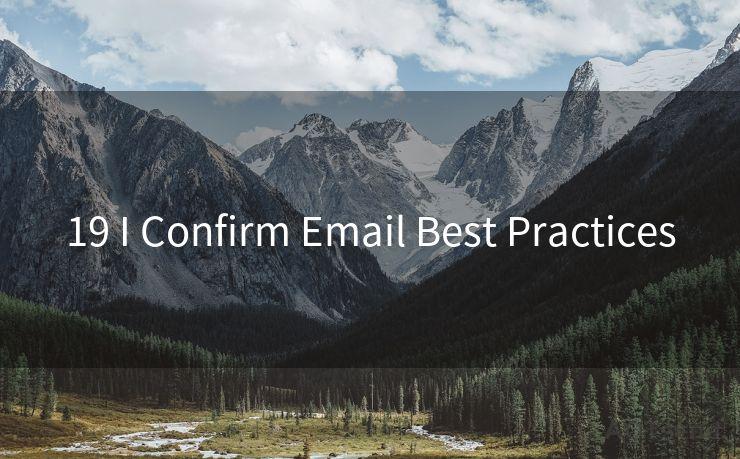19 I Confirm Email Best Practices




Email confirmation is a crucial aspect of online communication, especially in the realm of e-commerce, subscriptions, and online services. It not only verifies the recipient's email address but also ensures the delivery of important information. Here are 19 best practices for confirming emails that you should follow to optimize your email communication.
1. Clear Subject Line
Start with a clear and concise subject line that indicates the purpose of the email, such as "Confirm Your Email Address" or "Verify Your Account." This helps the recipient understand the email's intent immediately.
2. Personalized Greeting
Use the recipient's name in the greeting to add a personal touch and increase engagement. For example, "Dear John," instead of a generic "Dear User."
3. Explain the Purpose
Briefly explain why you're sending the confirmation email. Whether it's to verify their email address, activate an account, or confirm a subscription, make sure to clarify this early in the email.
4. Simple and Direct Call to Action
Include a prominent call to action (CTA) button or link that clearly instructs the user on what to do next. The CTA should be easy to spot and labeled with action-oriented text like "Confirm Email" or "Verify Now."
5. Use a Valid and Secure Link
Ensure that the confirmation link is valid, secure (HTTPS), and leads to a trusted domain. This enhances trust and security for the user.
6. Expiration Date for the Link
Include an expiration date for the confirmation link to maintain the security of the process. Inform the user that the link will expire after a certain period, typically 24-48 hours.
7. Mobile-Friendly Design
Optimize your email for mobile devices. Many users check their emails on the go, so it's essential that your confirmation email displays correctly on mobile screens.
8. Brand Consistency
Maintain brand consistency in your email design. Use your brand's colors, logo, and typography to reinforce brand recognition and trust.
9. Privacy and Security Information
Include a link to your privacy policy and, if possible, a brief note about the security measures you've taken to protect user data.
10. Contact Information
Provide easy-to-find contact information, such as a customer service email or phone number, in case the user has any questions or encounters issues.
11. Avoid Spam Triggers
Be cautious of spam triggers in your email content. Avoid using excessive capitalization, exclamation marks, or other elements that might flag your email as spam.
12. Test Email Deliverability
Regularly test your email deliverability to ensure that confirmation emails are reaching your recipients' inboxes and not being marked as spam.
13. Track and Measure Performance
Utilize email tracking tools to measure open rates, click-through rates, and other key metrics. This helps you understand how effective your confirmation emails are and where you can improve.
14. A/B Testing
Conduct A/B tests to optimize your confirmation email's design, content, and CTAs. This allows you to understand what works best for your audience.
15. Follow Up Emails
Consider sending a follow-up email if the user hasn't confirmed their email within a certain timeframe. This serves as a reminder and can increase conversion rates.
16. Multi-Language Support
If your audience is international, consider offering multi-language support in your confirmation emails. This enhances the user experience and increases engagement.
17. Accessibility
Ensure that your emails are accessible to all users, including those with disabilities. Use high color contrast, alt text for images, and clear, simple language.
18. GDPR Compliance
If you operate in the European Union or handle EU citizens' data, ensure that your confirmation emails are GDPR-compliant. Include necessary consent forms and opt-out options.
19. Keep It Simple
Finally, keep your confirmation emails simple and straightforward. Avoid unnecessary clutter and focus on the core message: verifying the user's email address or account.
By following these best practices, you can create effective and user-friendly confirmation emails that enhance the user experience, build trust, and improve conversion rates. Remember to continually test and optimize your emails to ensure they meet the needs and preferences of your target audience.
🔔🔔🔔
【AOTsend Email API】:AOTsend is a Managed Email Service for sending transactional emails. Support Email Types: reminders, authentication, confirmations, notifications, verification codes, invoices, password resets, account activations, billing statements, two-factor authentication (2FA), and one-time passwords (OTP) emails, etc. $0.28 per 1000 Emails. 99% Delivery, 98% Inbox Rate.
You might be interested in:
Why did we start the AOTsend project, Brand Story?
What is a Managed Email API, How it Works?
Best 25+ Email Marketing Platforms (Authority,Keywords&Traffic Comparison)
Best 24+ Email Marketing Service (Price, Pros&Cons Comparison)
Email APIs vs SMTP: How they Works, Any Difference?





Scan the QR code to access on your mobile device.
Copyright notice: This article is published by AotSend. Reproduction requires attribution.
Article Link:https://www.mailwot.com/p6370.html



